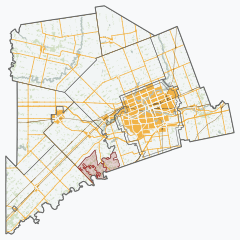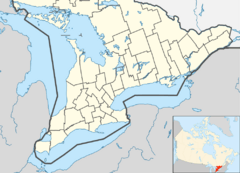Chippewas of the Thames First Nation facts for kids
Quick facts for kids
Chippewas of the Thames First Nation 42
Deshkaan-ziibing Aniishinaabeg
|
|
|---|---|
| Chippewas of the Thames First Nation Indian Reserve No. 42 | |
| Country | |
| Province | |
| County | Middlesex |
| First Nation | Chippewas of the Thames |
| Formed | 1819 |
| Area | |
| • Land | 39.11 km2 (15.10 sq mi) |
| Population
(2011)
|
|
| • Total | 762 |
| • Density | 19.5/km2 (51/sq mi) |
| Time zone | UTC-5 (EST) |
| • Summer (DST) | UTC-4 (EDT) |
| Postal Code |
N0L
|
| Area code(s) | 519 and 226 |
| Website | www.cottfn.com |
The Chippewas of the Thames First Nation (called Deshkaan-ziibing Aniishinaabeg in their language) is a community of Anishinaabe (Ojibway) people. They are a First Nation government located about 24 kilometers (15 miles) west of St. Thomas, in southwestern Ontario, Canada.
Their land is known as the Chippewas of the Thames First Nation 42 reserve. It covers about 3,652.60 hectares (9,025.7 acres). This reserve almost completely surrounds another reserve called Munsee-Delaware 1. As of January 2014, 2,738 people were registered as members, with 957 living on the reserve.
The Chippewas of the Thames are neighbors with the Munsee-Delaware Nation and the Oneida Nation of the Thames. The Oneida people call the Ojibway territory twaˀkʌnhá·ke.
Contents
Traditional Lands and Treaties
The Chippewas of the Thames First Nation has a special way of talking about their traditional lands, called "Wiindmaagewin." Their ancestral lands are in southwestern Ontario. These lands include areas north and south of the Thames River.
North of the Thames River, their traditional territory covers about 2.78 million acres. These lands are part of important agreements called the Longwoods Treaty (1822) and the Huron Treaty (1827). South of the Thames River, their territory is covered by the McKee Treaty (1790), the London Township Treaty (1796), and the Sombra Township Treaty (1796).
The Chippewas of the Thames are part of several of these treaties with other Anishinaabe nations. However, they are the only Anishinaabe group involved in the Longwoods Treaty. Their ancestral lands stretch from Lake Huron in the north to Lake Erie in the south. They also go eastward from the St. Clair and Detroit rivers. Historically, their territory even reached into parts of what are now the American states of Michigan and Ohio.
The Chippewas of the Thames First Nation has a Treaty Research Unit. This team studies the history of their treaties. All the treaties they signed happened before Canada became a country in 1867. This means they were made with the British Crown. Sometimes, the Crown did not fully keep its promises. Researchers work to find historical information to help the First Nation take legal action when needed.
Chippewa members can train to become Archaeology Field Liaisons or Monitors. These monitors learn to find old tools, remains, and types of stone used by their ancestors. They also learn how to test and dig at archaeology sites. The Ontario Archaeology Society provides this training. Developers and towns must have archaeology assessments done before building new things.
History of the Community
In 1763, Chief Seckas of the Thames River led 170 warriors. They joined the siege of Detroit during Pontiac's uprising.
The Chippewas of the Thames reserve was created in 1819. This was part of a treaty where the Chippewas agreed to share 552,000 acres (2,234 square kilometers) of land with the British. In return, they received an annual payment of £600. Two reserves were also established, with Reserve No. 42 being the larger one.
In 1840, the Chippewas made an agreement with the Munsee-Delaware Nation. They allowed the Munsee people to live on one square mile of land near the Thames River. This Munsee part of the reserve later became the Munsee-Delaware Nation No. 1 reserve in 1967.
Rights and the Duty to Consult
Aboriginal Rights and Treaty rights are very important for First Nations. They protect the special relationship Indigenous peoples have with their lands and traditions.
What is the Duty to Consult?
The "Duty to Consult" means that the government must talk with and listen to First Nations. This happens when a government decision might affect their Aboriginal or treaty rights. This is a key part of Section 35 of the Canadian Constitution.
A Recent Example: The Chippewas of the Thames First Nation had a concern about a pipeline. This pipeline, owned by Enbridge Pipelines Inc., crosses the Thames River. The river is within the Longwoods Treaty Territory, where the Chippewas have special rights.
The National Energy Board (NEB) allowed Enbridge to change the pipeline. These changes included reversing its flow and allowing heavier oil to be shipped. The Chippewas were worried about the possible harm to the river's health. They felt the NEB did not properly consider their rights or consult with them.
The First Nation took their concerns to the Supreme Court of Canada. They wanted the court to say that the government had a duty to consult them. In July 2017, the Supreme Court of Canada decided that the NEB did not have to decide if the Crown had a duty to consult. This was because the Crown was not directly involved in the NEB's original decision.
In response to these ongoing legal discussions, the Chippewas of the Thames created their own "Duty to Consult Protocol" in 2016. It is called Wiindmaagewin. This protocol explains how the First Nation expects companies and governments to work with them.
Environment and Conservation
The Chippewas of the Thames First Nation is located within the Thames River watershed. Several creeks, like Dawson Creek, Hogg Creek, and Big Monday Creek, flow into the Thames River through their community.
The First Nation's Environment Unit checks the health of the water. They do this by studying tiny organisms (bugs) that live in the riverbed. This is called Benthic sampling. The types and numbers of bugs tell them how clean the water is. The average water quality rating for the Chippewas of the Thames First Nation is "Fair."
The community has had a recycling program for many years. It started as a drop-off spot and is now a weekly curbside pick-up service. In May 2019, the recycling program helped avoid using 97 cubic yards of landfill space. It also saved 506,110 liters of water and 451 trees. Plus, it prevented 36,268 pounds of air pollution.
The Chippewas of the Thames First Nation also works with the Lower Thames Valley Conservation Authority (LTVCA). Because of this partnership, band members can get free parking permits for LTVCA conservation areas.
Governance and Leadership
The Chippewas of the Thames First Nation is led by a Chief and Council. These leaders are elected by the community. They serve for two-year terms. Elections are held in July every two years, in odd-numbered years.
Women Chiefs in History
The Chippewas of the Thames First Nation has had several women leaders.
- Arletta Silver was the first elected woman Chief. She was chosen in a special election on August 20, 1952. She served after the Indian Act changed in 1951, giving Indigenous women the right to vote.
- Leslee White-Eye was elected Chief in 2015. She was the second woman Chief in over 63 years. During her time as Chief, she helped finalize an agreement about the Greenlane Landfill site. This agreement released funds for the community. She also brought national attention to the First Nation's Supreme Court case against Enbridge. Chief White-Eye also helped create the Wiindmaagewin protocol. In July 2017, she received an honorary Doctor of Laws degree from Western University. This was for her work in improving relationships between the First Nation and nearby cities.
- Jacqueline S. French became the third elected woman Chief in 2019. She is currently serving her second term as Chief.
Education for the Future
The Chippewas of the Thames First Nation runs an elementary school for students from Kindergarten to Grade 8. It is called Antler River Elementary. It was formerly known as Wiiji Nimbawiyaang Elementary, which means 'together, we are standing' in Ojibwe.
Learning the Ojibwe Language
In 2017–2018, the school started an immersion program for the Anishinaabemowin (Ojibwe) language. This program began in Junior Kindergarten. Each year, another grade was added to the program. However, the immersion program was paused in Fall 2021 due to a shortage of teachers and other reasons.
How Education is Managed
In 1991, the Chief and Council decided to create a Board of Education. This board would be in charge of education matters for the First Nation. This meant the board would handle finances, staff, and curriculum development for the school. It also took over the Day Care system. The Board of Education and the Chief and Council work together on important education issues.
Community Numbers
In April 2004, the Chippewas of the Thames First Nation had 2,221 registered members. Of these, 876 lived on the reserve. By January 2011, the total registered population grew to 2,462, with 911 living on the reserve.
| Canada census – Chippewas of the Thames First Nation 42 community profile | |||
|---|---|---|---|
| 2006 | |||
| Population: | 747 (% from 2001) | ||
| Land area: | 39.11 km2 (15.10 sq mi) | ||
| Population density: | 19.1/km2 (49/sq mi) | ||
| Median age: | 33.4 (M: 30.5, F: 34.8) | ||
| Total private dwellings: | 288 | ||
| Median household income: | $27,200 | ||
| References: 2006 earlier | |||
Famous People
- Cody McCormick, an ice hockey player who played for the Buffalo Sabres.



